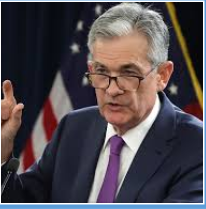Uddrag fra finanshuse og Zerohedge:
Sådan lyder analytikernes kommentarer til FED chef Powells statement om kommende rentenedsættelser:
Kevin Gordon, senior investment strategist at Charles Schwab:
“The speech helps to confirm—without officially confirming—a September rate cut, but not necessarily a full-blown cutting cycle,” “The market’s initial positive response reflects the comfort and relief of not being completely at odds with the Fed.”
Matt Maley, chief market strategist at Miller Tabak + Co LLC:
“This is an important shift for Chairman Powell. The question for the markets now is whether concerns over slower growth will cause earnings to decline, but the Fed is not going to create significant headwinds for investors.”
Dan Carter, porfolio manager at Fort Washington Investment Advisors;
“Even with Powell’s more dovish tone, the data in coming weeks still pose some risks. The market will like this change in tone. But I think we have to be careful not to get too far ahead. There is still a lot of data between now and the next FOMC meeting.”
Simon Penn, Macro Sales at UBS:
“Powell’s Message Is That An Inflection Point Has Been Reached; Payrolls Were A Critical Data Point. Fed Chair Powell’s Jackson Hole speech represents the framing and justification of an inflection in policy bias. It’s a very logically constructed set of observations. Powell’s opening is entirely context – here’s the economy over the first half of the year. Then he changes tack, by referencing July’s employment data. Threaded into the speech is a bit of subtle political push back – references to rates having been cut and inflation being lower than it was; and the great uncertainties and disruptions caused by policy elsewhere in Washington…. That all opens the way for the big reveal on policy: Powell hits the audience with the punchline: “With policy in restrictive territory, the baseline outlook and the shifting balance of risks may warrant adjusting our policy stance.” So, having laid it all out with the justifications, he provides the clear outcome – the policy bias has switched.
David Russell, Global Head of Market Strategy at TradeStation:
“Powell just flipped the mandate. His talk of labor market slack and slowing GDP growth moves the needle from price stability to full employment. Job growth is weak and continuing claims are on the rise. Better safe than sorry, especially with the political pressures Powell is facing. There’s a lot of data between now and the September meeting so there’s no reason to upset the apple cart right now. If the next jobs or CPI reports surprise to the upside, Powell can get more hawkish without hurting his credibility. But defying the market now would create major risk if the August data comes in light.”
Matthew Luzzetti, Chief US economist at Deutsche Bank:
“Chair Powell’s Jackson Hole speech leaned more dovish than we expected… Powell emphasized “the balance of risks appears to be shifting.” This showed increased concern around the labor market picture that could potentially warrant a policy response. Second, near the end of the discussion around the economic outlook, Powell noted “Nonetheless, with policy in restrictive territory, the baseline outlook and the shifting balance of risks may warrant adjusting our policy stance.” While this line was followed by the usual disclaimers around data dependence and not being on a preset course, it did not contain any conditionality around, or reference to, upcoming data points on the labor market or inflation. As such, we took this as a reasonably strong signal that Chair Powell is leaning towards a 25bps reduction in September. For our Fed view, we now see a 25bp rate cut in September as most likely. After that, we see the Fed delivering 25bp reductions in December and March, which would bring the fed funds rate to our longer-run estimate of nominal neutral.”
Leo He, UBS Macro Quant Strategist:
“Powell’s Jackson Hole Script More Dovish Than I Expected. I recommended receiving December 2025 FOMC into the Jackson Hole and the script turned out to be more dovish than I thought. First, Chair Powell noted the falling nonfarm payrolls may lead to sharply higher layoffs and rising unemployment. I mentioned last week that whenever the rolling 3-month nonfarm payrolls fell below 35, it was a turning point of the labor market. Second, his base case is still tariffs’ impact is a one-time shift in the price level. And lastly, he explicitly said with policy in restrictive territory, the baseline outlook and the shifting balance of risks may warrant adjusting our policy stance. Again, I think the fair pricing of 2025 Fed cut should be somewhere between 2 to 3 cuts, not 1 to 2.”
Needless to say, we agree with the dovish takes having presented it 2 days ago. The only question is whether we get 25 or 50bps, and based on what we believe will be revealed on Sept 9, the answer is the latter. More in the post later today.



